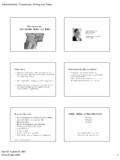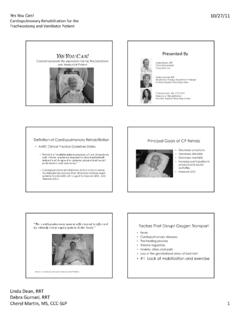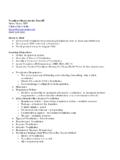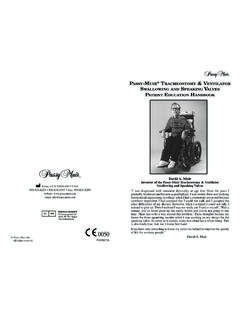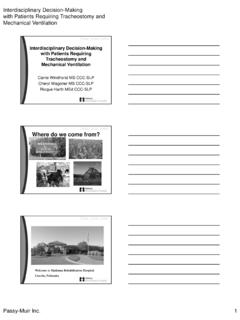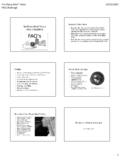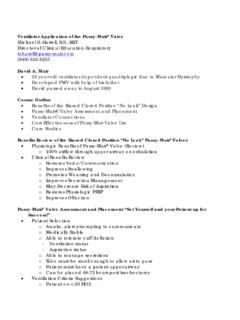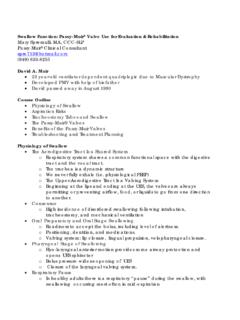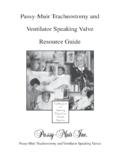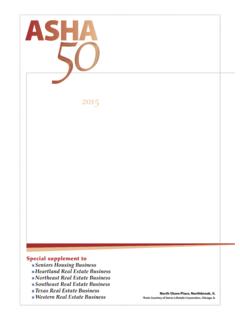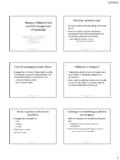Transcription of The Effect of Tracheostomy Speaking Valve use on ...
1 The Effect of Tracheostomy Speaking Valve use on Disordered Swallowing Blumenfeld, Liza1, Salgado M1, Wade K1, Dhupa A1, Ling E1, Belafsky P21. 1. Scripps Memorial Hospital La Jolla, La Jolla, CA 2. 2. UC Davis Medical Center, Sacramento, CA. Purpose: Tracheostomy tubes have been suggested to cause diminished laryngeal elevation, loss of subglottic pressure, decreased sensation, and mechanical obstruction. Speaking valves (SV). allow for improved communication and improvement in subglottic pressure. The precise Effect of SV use on swallowing function is uncertain. Method(s): Patients with a Tracheostomy tube who presented with dysphagia between 01/10/07 and 11/20/10 were prospectively evaluated. All patients were naive to previous SV use.
2 Participants were randomized to a SV or inner cannula control group. Patients underwent 4 days of identical swallowing therapy. The case group wore the SV for 45 minutes/day and during therapy. All patients were evaluated with endoscopic swallowing evaluation on Day 1 and Day 4. The treatment group had a SV placed during testing. The primary outcome measure was penetration aspiration scale (PAS). Secretion rating was utilized as a secondary measure. All outcomes were assessed from blinded digital recordings. Result(s): Twenty-one patients were enrolled (11 SV/10 controls). The mean age of the entire cohort was 54 (+/- SD) yrs and 30% was female. There were no age or gender differences between groups (p> ). No differences were noted in PAS or secretion rating between days 1 and 4 for the control group (p> ).
3 The PAS for the SV group improved from to (p< ) and the secretion rating improved from to (p< ). Conclusion: A Tracheostomy Speaking Valve may positively impact swallowing function and rehabilitation. Passy-MuirInc. Volume 38, Number 1 (2012). Effect of a Tracheostomy Speaking Valve on breathing swallowing interaction H l ne Prigent3, Mich le Lejaille3, Nicolas Terzi1, Djillali Annane, Marjorie Figere3, David Orlikowski3, Fr d ric Lofaso2. 1. INSERM, ERI27, Service de R animation M dicale, CHRU Caen, 14000 Caen, France 2. INSERMU 955, Cr teil, France 3. EA 4497, Universite de Versailles Saint-Quentin-en-Yvelines, 78035 Guyancourt, France Purpose: Expiratory flow towards the upper airway after swallowing serves to expel liquid or food particles misdirected towards the trachea during swallowing.
4 However, expiration may not occur consistently after swallowing in tracheostomised patients with an open Tracheostomy tube. We investigated the Effect of a Speaking Valve (SV) on breathing-swallowing interactions and on the volume expelled through the upper airway after swallowing. Methods: Eight tracheostomised neuromuscular patients who were able to breathe spontaneously were studied with and without an SV. Breathing-swallowing interactions were investigated by chin electromyography, cervical piezoelectric sensor, and nasal and tracheal flow recording. Three water-bolus sizes (5, 10, and 15 mL) were tested in random order. Results: Swallowing characteristics and breathing-swallowing synchronisation were not influenced by SV.
5 Use. However, expiratory flow towards the upper airway after swallowing was negligible without the SV and was restored by adding the SV. Conclusion: In tracheostomised patients, protective expiration towards the upper airway after swallowing is restored by the use of an SV. Passy-MuirInc. Journal of Korean Academy of Rehabilitation Medicine 2005 Apr; 29(2):225-230. Effect of Passy-Muir Speaking Valve in Brain-injured Patients with Dysphagia: Two cases report Im HL, Lee SY, Kang KJ, Choi IS, Kim JH, Lee SG, Park SJ. Department of Physical Medicine & Rehabilitation, Chonnam National University Medical School, Korea. Department of Physical Medicine & Rehabilitation, Chonnam National University Hwasun Hospital, Korea.
6 Department of Biomedical Engineering, Chonnam National University Hospital, Korea. Abstract: It is well known that the brain-injured patients with Tracheostomy is prone to frequent tracheopulmonary aspiration and dysphagia problems. We experienced two brain-injured patients with dysphagia, who revealed the improvement of clinical and videofluoroscopic parameters after application of Passy-Muir Speaking Valve (PMV 2000 , Passy-Muir Inc., USA). Two brain-injured patients had kept on nasogastiric and Tracheostomy tubes. After PMV. application for 2 weeks, the frequency of aspiration decreased, sleep hygiene and emotional lability improved, and also videofluoroscopic parameters such as pharyngeal delay time, pharyngeal transit time, and epiglottic closure were improved.
7 Eventually, they could be free from Tracheostomy tubes within 1 month after PMV application. Passy-MuirInc. Heart & Lung 2000 Jul-Aug;29(4):287-93. Effect of the Passy-Muir Tracheostomy Speaking Valve on pulmonary aspiration in adults Elpern EH, Borkgren Okonek M, Bacon M, Gerstung C, Skrzynski M. Rush-Presbyterian-St. Luke's Medical Center, Chicago, IL 60612, USA. Purpose: We determined instances of aspiration in adults with tracheostomies and investigated the Effect of the Passy-Muir Tracheostomy Speaking Valve on occurrences of aspiration. Methods: Adults with tracheostomies scheduled for videofluoroscopic swallowing examinations who met inclusion criteria were enrolled. According to study protocol, 6 presentations of thin liquids were recorded, 3 with and 3 without the Passy-Muir Tracheostomy Speaking Valve .
8 If a cuffed tube was present, the cuff was deflated fully for all presentations. Results: Seven of 15 subjects aspirated material on 1 or more presentations of thin liquid. Five subjects aspirated material only with the Passy-Muir Tracheostomy Speaking Valve off, whereas 2. subjects aspirated material with and without the Valve . No subject aspirated material while the Valve was on exclusively. Aspiration was significantly less frequent with the Passy-Muir Tracheostomy Speaking Valve on than with it off. Conclusions: Clinically unapparent aspiration occurs commonly in patients with tracheostomies. An expiratory occlusive Valve can reduce, though not eliminate, occurrences of aspiration. Clinical Implication: The benefit of the Passy-Muir Tracheostomy Speaking Valve should be evaluated in selected patients who aspirate liquid.
9 Passy-MuirInc. Head & Neck. 1995 Jul-Aug;17(4):297-302. Effect of the Passy-Muir Valve on Aspiration in Patients with Tracheostomy Dettelbach MA, Gross RD, Mahlmann J, Eibling DE. University of Pittsburgh School of Medicine, Department of Otolaryngology, PA 15213, USA. Objective: To assess potential benefit of a Passy-Muir Speaking Valve (PMV) in decreasing aspiration in patients with a Tracheostomy . Background: Many patients with Tracheostomy exhibit clinically significant aspiration. It has been previously noted that aspiration can often be reduced or eliminated by plugging or removing the Tracheostomy tube. Some patients, however, do not tolerate removal or plugging of their Tracheostomy tube, which then leads to persistent aspiration.
10 We postulated that a one-way Speaking Valve may restore more normal subglottic and glottic air flow and reduce aspiration. Methods: Alert patients with a Tracheostomy and clinical evidence of aspiration were eligible for study. Eleven patients with Tracheostomy and known aspiration were studied with a modified barium swallow. Radiographic examination was used to evaluate the presence and amount of aspiration while patients swallowed both with and without a PMV in place on their Tracheostomy tube. Results: Aspiration was reduced (or eliminated) during swallowing in all 11 patients when they wore a PMV, when compared to swallowing with an open (unvalved) tube. This improvement was achieved with liquids, semisolids, and pureed consistencies.
